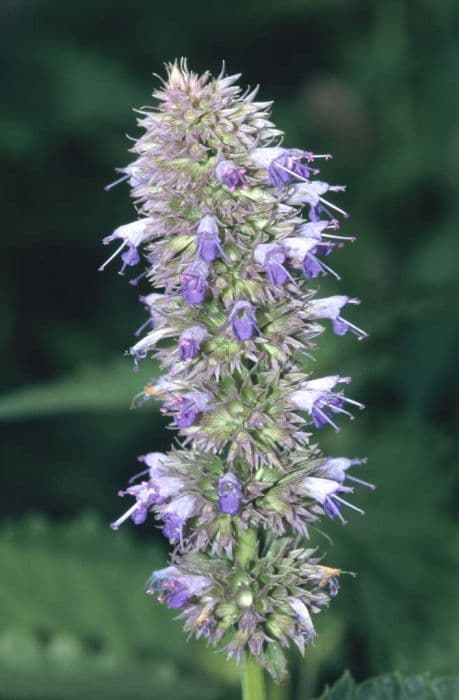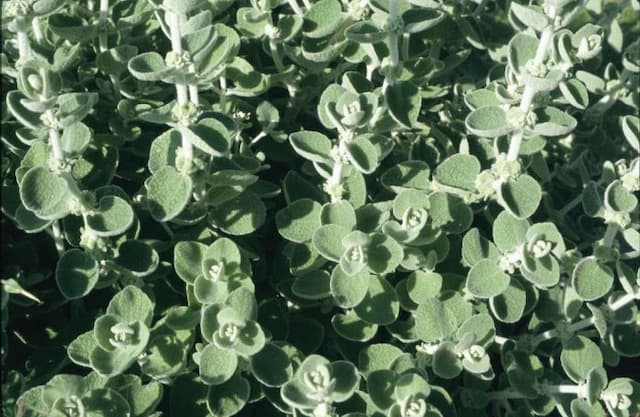Roseleaf Sage Salvia involucrata 'Boutin'

ABOUT
The plant in question, commonly known as Roseleaf Sage, exhibits a distinctive and appealing appearance. It features large, lush green leaves that are textured and slightly heart-shaped, creating a dense foliage backdrop. The leaves may have a soft, velvety feel, adding a tactile dimension to the plant's charm. The Roseleaf Sage is particularly adored for its striking flowers. The blooms are a vivid shade of magenta or rosy pink and typically form in elongated clusters, known as spikes or inflorescences, which project from the plant in an eye-catching display. These tubular flowers are particularly attractive to hummingbirds and butterflies, making the plant not only a visual but also an ecological asset to any garden space. The contrast between the bright flowers and dark green leaves makes the Roseleaf Sage a standout addition, providing a burst of color and lushness to the area it inhabits.
About this plant
 Names
NamesFamily
Lamiaceae
Synonyms
Roseleaf Sage, Beth's Blue Sage, Boutin Sage, Mexican Bush Sage
Common names
Salvia involucrata 'Boutin'.
 Toxicity
ToxicityTo humans
Roseleaf sage is generally considered non-toxic to humans. There is no significant toxicity associated with Roseleaf sage, and ingestion of this plant typically does not cause serious symptoms. However, as with any plant, individual allergies and sensitivities can vary, and it is always advisable to avoid ingesting plant material that is not known to be safe for consumption.
To pets
Roseleaf sage is not commonly listed as a toxic plant to pets such as dogs and cats. Ingestion of this plant should not cause significant symptoms of poisoning. As with humans, pets may have individual sensitivities, and it is always best to prevent pets from eating plants that are not intended for them, as gastrointestinal upset or allergic reactions could potentially occur from plant material that is not part of their normal diet.
 Characteristics
CharacteristicsLife cycle
Perennials
Foliage type
Deciduous
Color of leaves
Green
Flower color
Pink
Height
3-5 feet (0.91-1.52 meters)
Spread
2-3 feet (0.61-0.91 meters)
Plant type
Shrub
Hardiness zones
8
Native area
Mexico
Benefits
 General Benefits
General Benefits- Attracts Pollinators: Salvia involucrata 'Boutin', commonly known as Roseleaf Sage, attracts bees, butterflies, and other beneficial pollinators, enhancing biodiversity in the garden.
- Aesthetic Appeal: With its striking pink to magenta flowers, Roseleaf Sage adds vibrant color and visual interest to ornamental gardens and landscapes.
- Drought Tolerance: Once established, this plant is known for its ability to withstand periods of drought, making it suitable for xeriscaping and low-water gardens.
- Easy Maintenance: Roseleaf Sage is generally low maintenance, requiring minimal care once established, making it a good choice for gardeners of all skill levels.
- Long Blooming Period: The plant blooms from mid-summer to frost, providing a long season of color and interest in the garden.
- Cold Hardy: It is relatively cold hardy, which allows it to thrive in a variety of climates and to return year after year in regions where it is perennial.
- Herbaceous Perennial: As a perennial, the plant will regenerate each spring, offering a reliable feature in perennial borders and garden designs.
- Scented Foliage: The leaves of Roseleaf Sage can have a pleasant scent, adding a sensory experience to the garden when touched or brushed against.
- Versatile Planting Options: Roseleaf Sage is versatile and can be used in mixed borders, as a focal point, or in mass plantings for a dramatic effect.
- Companion Planting: Can be used in companion planting to benefit other plants in the garden, often by attracting the right kind of insects or by providing ground cover to help retain soil moisture.
 Medical Properties
Medical Properties- Salvia involucrata 'Boutin', commonly known as Roseleaf Sage, has traditionally been used in herbal medicine for its purported soothing effects on the nervous system.
- The plant is sometimes used in alternative medicine for its potential anti-inflammatory properties.
- It is also employed in local medicinal practices for its possible antioxidant activity.
- There exists traditional use as a remedy for certain digestive issues, although scientific evidence is limited.
- Some cultures use the plant for its reputed analgesic properties to naturally relieve pain.
 Air-purifying Qualities
Air-purifying QualitiesThis plant is not specifically known for air purifying qualities.
 Other Uses
Other Uses- The leaves of Salvia involucrata, also known as Roseleaf sage, can be used in potpourri for their fragrance and attractive color.
- Due to its large size and robust growth, Roseleaf sage can be planted as a hedge or privacy screen in a garden setting.
- Its vibrant and long-lasting flowers make it an excellent choice for adding a splash of color to flower arrangements and bouquets.
- As a nectar-rich plant, it is beneficial for creating a butterfly garden, attracting numerous butterfly species.
- The plant can be used in educational gardens to teach about pollination, due to its appeal to bees and other pollinators.
- Roseleaf sage's striking appearance makes it a suitable choice for themed gardens, such as those focusing on a pink color scheme or salvias specifically.
- The dried flowers can also be incorporated into craft projects, such as homemade paper, for texture and decorative elements.
- For culinary use, the flowers can be crystallized and used as edible decorations on cakes and desserts.
- In dye gardens, the plant material from Roseleaf sage can be used to create natural dyes for fabrics or yarns.
- Its essential oil, although not commonly used, can sometimes be included in custom perfumery or aromatherapy blends.
Interesting Facts
 Feng Shui
Feng ShuiThe Salvia is not used in Feng Shui practice.
 Zodiac Sign Compitability
Zodiac Sign CompitabilityThe Salvia is not used in astrology practice.
 Plant Symbolism
Plant Symbolism- Wisdom - The name "Salvia" originates from the Latin word "salvere," which means "to save" or "to heal." Salvia is commonly associated with wisdom and has been used in various cultural contexts to symbolize knowledge and experience.
- Immortality - Traditionally, some species of Salvia are believed to promote longevity and even immortality. Salvia involucrata could be linked to this concept due to its enduring and robust nature.
- Healing - Salvia has a longstanding association with healing due to its medicinal properties. It symbolizes the ability to heal both physical and emotional wounds.
- Spiritual Enlightenment - In some cultures, Salvia is used in spiritual practices to induce visions and promote enlightenment, symbolizing a deeper understanding of the spiritual realm.
- Protection - Some believe that Salvia has protective qualities, using it in rituals to ward off evil and provide a safe space from negative energies.
 Water
WaterRoseleaf sage prefers consistent moisture, but it's crucial not to overwater to prevent root rot. During active growth in spring and summer, water deeply once a week, providing about 1.5 gallons per plant, ensuring the soil is moist but not soggy. In cooler weather or when rain is frequent, reduce watering. Ensure the top inch of soil has dried out before watering again. It's beneficial to use a soaker hose or drip irrigation to water at the soil level and avoid wetting the foliage, which can lead to fungal diseases.
 Light
LightThe roseleaf sage thrives in full sun to partial shade, with optimal growth seen in locations that receive at least six hours of direct sunlight daily. An east or west-facing garden spot with morning or late afternoon sun is ideal, as it would provide the bright conditions without intense midday heat that can sometimes stress the plant.
 Temperature
TemperatureRoseleaf sage does best in temperatures ranging from 50°F to 85°F, showing optimal growth in this range. While it can tolerate a brief dip to around 32°F, frost can be damaging, so it's important to protect it during cold snaps. During the hot summer months, adequate watering is vital to prevent stress when temperatures exceed 85°F.
 Pruning
PruningPruning roseleaf sage encourages bushiness, prevents legginess, and promotes more vigorous flowering. Prune early in the spring to remove any dead or damaged wood and to shape the plant. Additionally, cutting back the plant by one-third after the first bloom can stimulate a second flush of flowers. The best time for heavy pruning is just before new growth begins in spring.
 Cleaning
CleaningAs needed
 Soil
SoilRoseleaf Sage thrives in a soil mix that is rich in organic matter with good drainage. A mix of two-parts garden soil to one-part compost and one-part perlite or coarse sand is ideal. The pH should be slightly acidic to neutral, roughly between 6.0 and 7.0.
 Repotting
RepottingRoseleaf Sage should be repotted every 2 to 3 years to refresh the soil and accommodate root growth. Optimal timing for repotting is during spring or early summer.
 Humidity & Misting
Humidity & MistingRoseleaf Sage prefers moderate to high humidity levels but is adaptable to less humid conditions. Strive to maintain humidity around 40-50%.
 Suitable locations
Suitable locationsIndoor
Provide bright light, keep moist, and ensure good air circulation.
Outdoor
Full sun to partial shade, protect from harsh conditions.
Hardiness zone
8-10 USDA
 Life cycle
Life cycleSalvia involucrata 'Boutin', commonly known as Roseleaf Sage, begins its life as a seed, often requiring a period of stratification to break dormancy. After germination, the seedling develops a root system and true leaves during its early growth stage. As it matures, the plant undergoes vegetative growth, characterized by the expansion of its leafy stems and foliage. The next phase is the flowering stage, where it produces striking pink to magenta flowers, usually from late summer through the fall, attracting pollinators to aid in reproduction. After pollination, the plant produces seeds, which complete the reproductive cycle. Following seed set, in climates with colder winters, the Roseleaf Sage may die back to the ground, only to regrow from its root system when the weather warms in spring.
 Propogation
PropogationPropogation time
Spring to Summer
Salvia involucrata 'Boutin', commonly known as the Roseleaf Sage, can be propagated most effectively through semi-ripe stem cuttings during the summer months when the plant is actively growing. To propagate, select a healthy, non-flowering stem and cut a 4 to 6 inch (10 to 15 cm) length. Remove the lower leaves to expose a clean section of stem. Dip the cut end into rooting hormone powder to encourage root development and plant it in a pot filled with a mix of peat and perlite. Ensure the soil is kept moist but not waterlogged, and place the pot in a warm area with indirect sunlight. Roots typically develop within a few weeks, after which the new Salvia can be transplanted to a more permanent location.









